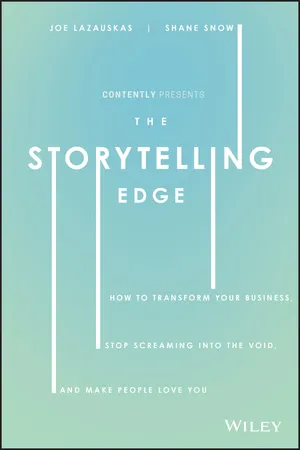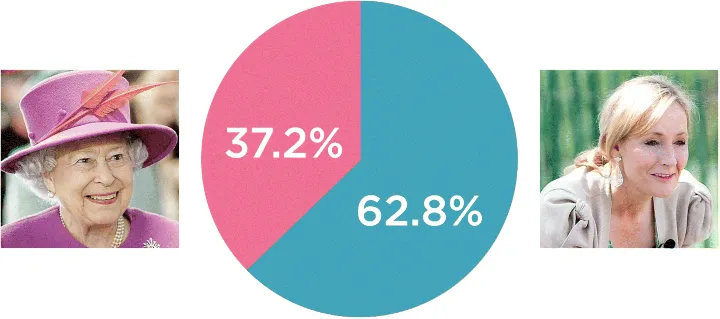
The Storytelling Edge
How to Transform Your Business, Stop Screaming into the Void, and Make People Love You
- English
- ePUB (mobile friendly)
- Available on iOS & Android
The Storytelling Edge
How to Transform Your Business, Stop Screaming into the Void, and Make People Love You
About This Book
"A terrific and timely book that makes a compelling case for fundamentally rethinking how your business communicates. Recommended!"
— Jay Baer, founder of Convince & Convert and author of Hug Your Haters "Once upon a time, storytelling was confused with talking at people. Not anymore. Shane and Joe are your narrators in a journey that will transform how you talk to other human beings to be more believable, relevant, compelling and unforgettable."
— Brian Solis, experience architect, digital anthropologist, best-selling author
"Shane Snow and Joe Lazauskas spend the overwhelming majority of their time thinking, writing, and theorizing about brand storytelling - so you don't have to. They're smart and they know this topic inside out (and sideways). Read their book. While I can't guarantee you'll rise to Shane and Joe's ridiculously obsessive level, you will be infinitely better prepared to tell your own brand's story. Promise!"
— Rebecca Lieb, Analyst, Author & Advisor
"The Contently team understands the power of story, and how to craft and spread a great narrative, like no other. In an era where brand, design, and mission are a competitive advantage for every business, Contently underscores the importance of stories and how they transform companies and industries."
— Scott Belsky, Entrepreneur, Investor, & Author (Founder of Behance, bestselling author of Making Ideas Happen )
"I can't think of a better way to illustrate the power of story telling than by telling great stories. This book should be required reading not just by those with content in their titles, but by anyone in Marketing AND Sales. Then, when you're done, give it to your CEO to read... but make sure you get it back, because I guarantee you'll refer to it more than once."
— Shawna Dennis, Senior Marketing Leader
"Neuroscience, algorithms, illustrations, personal anecdotes and good, old-fashioned empathy: This entertaining and informative tome journeys to the core of how we communicate and pushes us, as marketers and humans, to do it better, "speeding the reader through and leaving us wanting more."
— Ann Hynek, VP of global content marketing at Morgan Stanley
Transform your business through the power of storytelling.
Content strategists Joe Lazauskas and Shane Snow offer an insider's guide to transforming your business—and all the relationships that matter to it—through the art and science of telling great stories.
Smart businesses today understand the need to use stories to better connect with the people they care about. But few know how to do it well. In The Storytelling Edge, the strategy minds behind Contently, the world renowned content marketing technology company, reveal their secrets that have helped award-winning brands to build relationships with millions of advocates and customers.
Join as they dive into the neuroscience of storytelling, the elements of powerful stories, and methodologies to grow businesses through engaging and accountable content.
With The Storytelling E dge you will discover how leaders and workers can craft the powerful stories that not only build brands and engage customers, but also build relationships and make people care—in work and in life.
Frequently asked questions
Information
1
The Power of Story

Jacques and the Beggar
And Now for Shane's Favorite Ryan Gosling Story
Our Brains Are Built for Story
Under Coffin's watchful eye, the helmsman brought the ship as close as possible to the derelict craft. Even though their momentum quickly swept them past it, the brief seconds during which the ship loomed over the open boat presented a sight that would stay with the crew the rest of their lives…First they saw bone—human bones—littering the thwarts and floorboards, as if the whaleboat were the seagoing lair of a ferocious man-eating beast.Then they saw the two men.They were curled up in opposite ends of the boat, their skin covered with sores, their eyes bulging from the hollows of their skulls, their beards caked with salt and blood. They were sucking the marrow from the bones of their dead shipmates.1
Table of contents
- Cover
- Endorsements
- Title Page
- Copyright
- Dedication
- Acknowledgments
- About the Authors
- Introduction
- Chapter 1: The Power of Story
- Chapter 2: The Elements of Great Storytelling
- Chapter 3: Honing Your Storytelling Chops
- Chapter 4: Transforming Business with Storytelling
- Chapter 5: The Killer Formula for Building an Audience
- Chapter 6: The Brand Newsroom
- Chapter 7: The Future of Brand Storytelling
- Chapter 8: The Storytelling Habit
- Index
- End User License Agreement